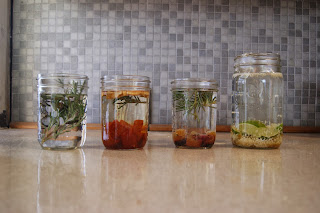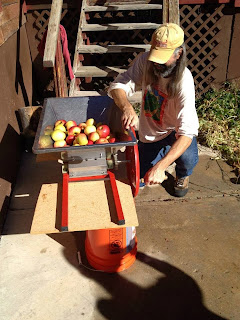Hard Cider- One of
History’s Great DIY Projects
By Chris Gleason

Seen through the eyes of this completely biased reporter, hard
apple cider is having a moment. Even
Eric Asimov, wine critic for the New York
Times, recently devoted a column to its recent rise in popularity. He noted that a number of large corporations-
Anheuser Busch, among others- are moving to acquire, establish, or grow cider
brands, and this is an interesting turn of events. While I’m not a knee-jerk fan of corporate
food production, Big Cider (a term I invoke with a giggle) there might be some
good news here: by turning a more people on to the deliciousness of hard cider,
it is inevitable that a lot of folks will get inspired to make cider on their
own. And this is inherently a great
thing: it uses local produce, it’s a fun do-it-yourself project, and it saves
money as compared to buying the mass-produced stuff. It is also satisfying in a
history-repeats-itself kind of way: back in the Colonial Era, hard cider was
the most common alcoholic beverage. So,
if you’re the kind of person who likes to fan the flames of a great old
tradition, you might want to give cider-making a try.
Like lots of other DIY projects, cider-making exists on a
sort of continuum of complexity. You can
easily make cider in minutes from a gallon jug of store-bought juice, or you
can gather your own apples and press them into cider on your own. It just depends on how much time, money, and
energy you want to put into the endeavor.
Ultimately, there is a lot of satisfaction from having your fingerprints
on each step of the process and doing it “the hard way”, so it is worth trying
at least once, but to keep things simple, I’ll begin at the beginning: with a
gallon of pre-made apple cider. My next
post will cover the process starting with a few bushels of apples and an
old-school press.
You can use apple juice or apple cider- just make sure the
label indicates that there are no preservatives, as this will kill of the yeast
that you’ll be adding. Pasteurized juice or cider are fine- that
means that the naturally occurring wild yeasts have been eradicated. Either way, you’ll need to procure a couple
of things from a homebrew store: an airlock and yeast. An airlock is a nifty little device that
allows CO2 (carbon dioxide) to escape from the fermenting brew while keeping
oxygen out. Failing to do so starts you
down the road to making vinegar, but that’s a story for another time. Either way, you’ll use the glass jug that the
cider/juice came in, and you can add a cup of brown sugar if you’d like.
To add the yeast, you can simply pitch it right into the
jug- I do- or you can make a starter to check and see if your yeast are in fact
still alive. You might want to do this
if you’ve have bad luck in the past, or if you are using old yeast
packets. If you’ve just purchased yeast
for a trustworthy place, however, you can probably feel just fine about
skipping this step. To make a starter,
just add a cup of warm water (95-105 degrees) to the yeast, and add a spoonful
of sugar. It should start to bubble up
within fifteen minutes or so. If it
does, add it to the yeast to the bottle, and add the airlock. Pour some water into the airlock as directed,
and begin playing the waiting game.
Within a day or so, you should see some bubbles pop up
through the airlock- this means that the cider yeast have started to feast on
the sugars in the jug. This process will
last between 5 and 15 days, usually.
After a month, you’ll see a pile of sludge at the bottom this is
referred to as “the lees”, and it is made up of spent yeast and other particles
that can add an off flavor to your finished cider). Your goal now will be to remove the cider
from the jug without mixing the lees into it.
The best way to do this is with a siphon, which can be as simple as a
length of $1 length of food-grade tubing.
Once you’ve moved the cider into another container (this process is
called “racking”), you begin round two of the waiting game, which is generally
even longer. Most folks wait about six
months before imbibing. Cider-making,
unfortunately, is not for those lacking in patience.
However... there is hope for the impulsive among us, and I put
myself at the top of that list. I always
taste cider after a month, and I often find it perfectly
drinkable. You can go ahead and suggest
that I have low standards, and you're sort of right. More precisely, though, I lack the mindset
of a connoisseur. When it comes to things that cross my palate, I essentially distinguish between things that I like and do
not like. That is to say, when I make
cider, I don’t chase too hard after specific attributes ("notes of maple syrup in the finish", etc). To continue the analogy: I make pizza dough once a week. It usually comes out a little different every
time. I’m fine with that, because its
always delicious. I have no interest in
mastering the subtleties a perfect cracker-thin crust, etc. The way my brain is wired- and I really think it comes down to fundamental personality attributes as much as anything else- usually allows me
to be really happy with “good enough” month-old cider, especially when I know
that I’ve got a bunch more that I won’t get to until it actually sees its
six-month-a-versary.
The moral of the story is that I recommend taking a swig after a month- if it tastes yeasty or off or you just plain hate it, let it sit. If the flavors
speak to you, on the other hand, you just won the Cider Jackpot.
A
Middle-of-the-Road Option
If you want to try something a little more involved but don’t
quite want to step up to a full-on cider press experience, you can use a juicer
to grind up the apples. My juicer doesn’t
produce a truly liquidy cider- maybe a high-end, expensive model would?- but I
was able to strain the pulp and make things work. I also enlisted a blender. This method works, but there are two
drawbacks that I noticed. First of all,
it was slow- it took me about an hour and a half to get a gallon of cider- and
secondly, I felt like the resulting mash/pulp still contained a lot of liquid
that I couldn’t extract. This lack of
efficiency- perceived waste, really- bugged me until I realized it could be
turned into applesauce. And since we’re
hosting a Thanksgiving dinner next week, that felt pretty serendipitous.
Tip: the
yeast of your worries
Champagne yeasts will produce a drier cider, whereas ale
yeasts yield slightly sweeter ciders. If
you’re not sure which you prefer, go with your gut and see how it goes. Test both types of yeast by doing two
batches. The cost of yeast won’t break
the bank- its priced around $1 for a packet that’ll ferment up to 5 gallons of
cider.






























